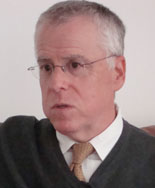
Tom Rosenstiel
Director, Project for Excellence in Journalism
Tom Rosenstiel designed the Project for Excellence in Journalism (PEJ; www.journalism.org) at the Columbia University Graduate School of Journalism. In 2006, PEJ became affiliated with the Pew Research Center, where Rosenstiel directs its activities.
According to the PEJ website, “Our goal is to help both the journalists who produce the news and the citizens who consume it develop a better understanding of what the press is delivering, how the media are changing, and what forces are shaping those changes. We have emphasized empirical research in the belief that quantifying what is occurring in the press, rather than merely offering criticism, is a better approach to understanding.”
At PEJ, Rosenstiel is the editor and principal author of PEJ’s “Annual Report on the State of the News Media,” (http://stateofthemedia.org/) a comprehensive report on the health of American journalism. He also directs the Project’s other research efforts, including the News Coverage Index and the New Media Index.
Rosenstiel’s newest book, with Bill Kovach, former editor, Atlanta Journal-Constitution and former curator, the Nieman Foundation, is “Blur: How to Know What’s True in the Age of Information Overload,” (Bloomsbury 2010).
Among his other books, Rosenstiel is the author, with Kovach, of “The Elements of Journalism: What Newspeople Should Know and the Public Should Expect” (Crown 2001, updated 2007), winner of the Goldsmith Book Prize from Harvard University, the SPJ Sigma Delta Chi award for research in journalism and the Bart Richards Award for Media Criticism from Penn State. Rosenstiel and Kovach are also the authors of “Warp Speed: America in The Age of Mixed Media”(Century Foundation 1999).
Rosenstiel is also vice chairman of the Committee of Concerned Journalists, (www.concernedjournalists.org). Rosenstiel previously was a media critic for the Los Angeles Times and chief congressional correspondent for Newsweek.
[B7 0101] - Part 1: Newspapers & Web Revenues (10:49)
Tom Rosenstiel, director, Project for Excellence in Journalism, says smaller community newspapers are doing better overall (than major market metros) because the content these newspapers offer is likely to be unique, their reporting is not a commodity and their advertisers are small and local, and therefore tied to the local community. Rosenstiel says the problem facing all newspapers is “more precisely a revenue problem than it is an audience problem.” Newspaper organizations are building readership numbers with their websites, but their newspaper-based advertisers “are not migrating with newspapers to their websites” to purchase ads there, even as the audience grows. Even when they do, since there is “no scarcity of websites,” the revenue newspaper organizations are getting on their websites is earned at reduced rates. (About 10 percent of print rates, according to WNN reporting.) Rosenstiel says Pew Research Center findings indicate display advertising is also much less effective on the web than in print. “Eighty percent of [Internet] users say they have never clicked on a web [display] ad,” says Rosenstiel. This can be attributed to the fact that, according to Rosenstiel, the web is a “lean-forward medium,” a concept he explains in this interview.
[B7 0102] - Part 2: Quest for New Revenues (4:39)
Tom Rosenstiel, director, Project for Excellence in Journalism, says the institution of niche digital news services, so-called “verticals” -- specialized topic, web news products – may become a useful source of incremental revenue for newspapers if there is a “big enough audience to justify the expense and a deep enough interest.” But, overall, he fears “the newspaper industry is a victim of its own conservative cultural blinkers that have let the opportunities of the last decade slip through [its] fingers.”
[B7 0103] - Part 3: Community Journalism (9:11)
Tom Rosenstiel, director, Project for Excellence in Journalism, says attempts at stimulating “community journalism” – using community members to generate fresh news content to supplement or replace professional journalists – have yielded mixed results to date. Converting community members into reporters has proven “not workable,” says Rosenstiel. On the other hand, he believes tapping into a community for sources of expertise can magnify a news organization’s source of information “a thousand-fold.” “Having [community members] be surrogate reporters is not as good as having them be citizens who offer eyewitness testimony, which then can be converted into something more,” says Rosenstiel. “I think the idea that you could cover a community with untrained volunteers is probably … a long shot.” Concomitantly, “if we devalue and underfund the professional journalists,” says Rosenstiel, “you will get what you pay for.”
[B7 0104] - Part 4: Newspaper Industry Leadership (6:44)
Tom Rosenstiel, director, Project for Excellence in Journalism, says that managers from other industries who enter journalism without understanding a newspaper’s “inviolate relationship” with its readers -- to maintain independence and seek the truth -- often fail “by violating the secret covenant with the readers.” At the same time, indigenous newspaper managers ran businesses where “it was easy to make money” for many years. “[The industry] did not require a lot of innovation,” says Rosenstiel. Newspapers are paying for that strategic lassitude. “It’s a bit late to be thinking about cultural change,” says Rosenstiel. “They need to do it, but they need to do it fast.”
[B7 0105] - Part 5: Profit Margins & the Stakes (5:04)
Tom Rosenstiel, director, Project for Excellence in Journalism, says profit margins, per se, are not a good industry indicator. The key question, says Rosenstiel, is: “Is the business growing?” Looking back, the problem was “we were growing our revenue, but we weren’t investing anything – to speak of – in re-invention,” says Rosenstiel. “Americans have a stake in the health and survival of newspapers.” At stake is every community’s knowledge about itself. “It’s very significant,” says Rosenstiel. “In every community we’ve ever looked at, the newspaper is the largest news organization. It has more people covering more topics and more places than radio, than television, than any Internet operation combined … than in all the other media combined. So if the newspaper dies, a good deal of what occurs in civic life, at least initially, will occur in shadow. We won’t know about it. Whether some new ecosystem will form to replace it … is unknown,” says Rosenstiel. “The other alternative is that newspapers re-invent their economic engine in some manner … and the next four or five years will provide the answer to that.”



